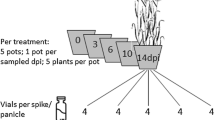Abstract
Rice blast disease, described over 300 years ago, has been the subject of research in plant pathology labs throughout the world [17]. The fungus Magnaporthe grisea (anamorph, Pyricularia sp.), an ascomycete, has been of considerable interest because of its global agronomic impact in inciting blast disease and because it is recognized as one of the most widely disseminated foliar pathogens. In recent years M. grisea has become more valuable for investigation because it can be genetically manipulated and characterized [5, 7, 9, 15, 18, 23–25]. For these reasons we have undertaken the task of redefining the early events of host-pathogen interaction: inoculation, pre-penetration and penetration, all prerequisites of infection. This chapter briefly summarizes several new and significant findings of an in vitro analysis concerning conidial adhesion, appressorium development, and the mechanism of penetration. Many of these new findings can be ascribed to our use of freeze substitution [12] for sample preparation.
Access this chapter
Tax calculation will be finalised at checkout
Purchases are for personal use only
Preview
Unable to display preview. Download preview PDF.
Similar content being viewed by others
References
Aronson JM (1981) Cell wall chemistry, ultrastructure, and metabolism. In: Cole GT, Kendrick B (eds) Biology of conidial fungi, Vol 2. Academic Press, New York, pp 459
Beckett A, Porter R (1988) The use of complementary fractures and low-temperature scanning electron microscopy to study hyphal-host cell surface adhesion between Uromyces viciae-fabae and Vicia faba. Can J Bot 66: 645–652
Bourett TM, Howard RJ (1990) In vitro development of penetration structures in the rice blast fungus. Magnaporthe grisea. Can J Bot 68: 329–342.
Chau KF, Alvarez AM (1983) A histological study of anthracnose on Carica papaya. Phytopathology 73: 1113–1116
Chumley FG, Valent B (1990) Genetic analysis of melanin deficient nonpathogenic mutants of Magnaporthe grisea. Mol Plant-Microbe Interactions 3: 135–143.
Clark CA, Lorbeer JW (1976) Comparative histopathology of Botrytis squamosa and B. cinerea on onion leaves. Phytopathology 66: 1279–1289
Crawford MS, Chumley FG, Weaver CG, Valent B (1986) Characterization of the heterokaryotic and vegetative diploid phases of Magnaporthe grisea. Genetics 114: 1111–1129
Hamer JE, Howard RJ, Chumley FG, Valent B (1988) A mechanism for surface attachment in spores of a plant pathogenic fungus. Science 239: 288–290
Hamer JE, Valent B, Chumley FG (1989) Mutations at the SMO genetic locus affect the shape of diverse cell types in the rice blast fungus. Genetics 122: 351–361
Hau FC, Rush MC (1982) Preinfectional interactions between Helminthosporium oryzae and resistant and susceptible rice plants. Phytopathology 72: 285–292
Howard RJ, Ferrari MA (1989) Role of melanin in appressorium function. Exp Mycol 13:403–418
Howard RJ, O’Donnell KL (1987) Freeze substitution of fungi for cytological analysis. Exp Mycol 11:250–269
Keitt GW, Jones LK (1926) Studies of the epidemiology and control of apple scab. Wis Agrie Exp Stn Res Bull 73: 1–104
Landes M, Hoffmann GM (1979) Zum Keimungs- und Infektionsverlauf bei Colletotrichum lindemuthianum auf Phaseolus vulgaris. Phytopathol Z 95: 259–273
Leung H, Borromeo ES, Brenardo MA, Notteghem JL (1988) Genetic analysis of virulence in the rice blast fungus Magnaporthe grisea. Phytopathology 78: 1227–1233
McKeen WE, Rimmer SR (1973) Initial penetration process in powdery mildew infection of susceptible barley leaves. Phytopathology 63: 1049–1053
Ou SH (1985) Rice Diseases, 2nd edn Commonwealth Agricultural Bureaux, Slough, UK
Parsons KA, Chumley FG, Valent B (1987) Genetic transformation of the fungal pathogen responsible for rice blast disease. Proc Natl Acad Sci USA 84: 4161–4165
Porto MDM, Grau CR, de Zoeten GA, Gaard G (1988) Histopathology of Colletotrichum trifolii on alfalfa. Phytopathology 78: 345–349
Potts JE (1984) Plastics, environmentally degradable. In: Eckroth D (ed) Encyclopedia of chemical technology, 3rd edn, Suppl Vol Wiley, New York, pp 626
Turner ML, MacHardy WE, Gadoury DM (1986) Germination and appressorium formation by Venturia inaequalis during infection of apple seedling leaves. Plant Dis 70: 658–661
Uchiyama T, Ogasawara N, Nanba Y, Ito. H (1979) Conidial germination and appressorial formation of the plant pathogenic fungi on the coverglass or cellophane coated with various lipid components of plant leaf waxes. Agrie Biol Chem 43: 383–384
Valent B, Chumley FG (1987) Genetic analysis of host species specificity in Magnaporthe grisea. UCLA Symp Mol Cell Biol (New Series) 48: 83–93
Valent B, Crawford MS, Weaver CG, Chumley FG (1986) Genetic studies of pathogenicity and fertility of Magnaporthe grisea. Iowa State J Res 60: 569–593
Valent B, Farrall L, Chumley FG (1990) Magnaporthe grisea genes for pathogenicity and virulence identified through a series of backcrosses. Genetics (in press)
Author information
Authors and Affiliations
Editor information
Editors and Affiliations
Rights and permissions
Copyright information
© 1991 Springer-Verlag Berlin Heidelberg
About this chapter
Cite this chapter
Howard, R.J., Bourett, T.M., Ferrari, M.A. (1991). Infection by Magnaporthe: An In Vitro Analysis. In: Mendgen, K., Lesemann, DE. (eds) Electron Microscopy of Plant Pathogens. Springer, Berlin, Heidelberg. https://doi.org/10.1007/978-3-642-75818-8_19
Download citation
DOI: https://doi.org/10.1007/978-3-642-75818-8_19
Publisher Name: Springer, Berlin, Heidelberg
Print ISBN: 978-3-642-75820-1
Online ISBN: 978-3-642-75818-8
eBook Packages: Springer Book Archive




